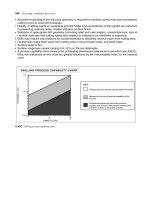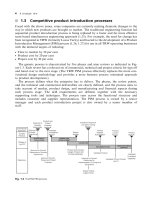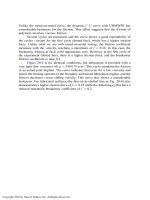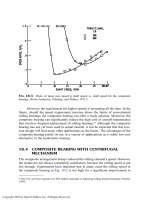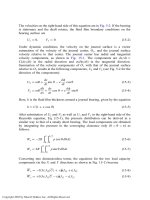Bearing Design in Machinery Episode 1 Part 4 pps
Bạn đang xem bản rút gọn của tài liệu. Xem và tải ngay bản đầy đủ của tài liệu tại đây (215.85 KB, 17 trang )
u ¼ uðyÞ, the relation between the shear stress and the shear rate is described by
the following equation:
t þ l
dt
dt
¼ m
du
dy
ð2-9Þ
Here, l is the relaxation time (having units of time). The second term with the
relaxation time describes the fluid stress-relaxation characteristic in addition to
the viscous characteristics of Newtonian fluids.
As an example: In Newtonian fluid flow, if the shear stress, t, is sinusoidal,
it will result in a sinusoidal shear rate in phase with the shear stress oscillations.
However, according to the Maxwell model, there will be a phase lag between the
shear stress, t, and the sinusoidal shear rate. Analysis of hydrodynamic lubrica-
tion with viscoelastic fluids is presented in Chapter 19.
Problems
2-1a A hydrostatic circular pad comprises two parallel concentric disks,
as shown in Fig. 2-5. There is a thin clearance, h
0
between the disks.
The upper disk is driven by an electric motor (through a mechanical
drive) and has a rotation angular speed o. For the rotation, power is
required to overcome the viscous shear of fluid in the clearance.
Derive the expressions for the torque, T, and the power,
_
EE
f
, provided
by the drive (electric motor) to overcome the friction due to viscous
shear in the clearance. Consider only the viscous friction in the thin
clearance, h
0
, and neglect the friction in the circular recess of radius
R
0
.
For deriving the expression of the torque, find the shear
stresses and torque, dT, of a thin ring, dr, and integrate in the
boundaries from R
0
to R. For the power, use the equation,
_
EE
f
¼ To.
Show that the results of the derivations are:
T
f
¼
p
2
m
R
4
h
0
1 À
R
4
0
R
4
o ðP2-1aÞ
_
EE
f
¼
p
2
m
R
4
h
0
1 À
R
4
0
R
4
o
2
ðP2-1bÞ
2-1b A hydrostatic circular pad as shown in Fig. 2-5 operates as a
viscometer with a constant clearance of h
0
¼ 200 mm between the
disks. The disk radius is R ¼ 200 mm, and the circular recess radius
is R
0
¼ 100 mm. The rotation speed of the upper disk is 600 RPM.
The lower disk is mounted on a torque-measuring device, which
reads a torque of 250 N-m. Find the fluid viscosity in SI units.
Copyright 2003 by Marcel Dekker, Inc. All Rights Reserved.
at a speed of 3600 RPM inside the bushing. The diameter of the
shaft is D ¼ 50 mm, while the radial clearance C ¼ 0:025 mm. (In
journal bearings, the ratio of radial clearance, C, to the shaft radius
is of the order of 0.001.) The bearing length is L ¼ 0:5D. The
viscosity of the oil in the clearance is 120 Saybolt seconds, and its
density is r ¼ 890 kg=m
3
.
a. Find the torque required for rotating the shaft, i.e., to
overcome the viscous-friction resistance in the thin clear-
ance.
b. Find the power losses for viscous shear inside the clearance
(in watts).
2-4 A journal is concentric in a bearing with a very small radial
clearance, C, between them. The diameter of the shaft is D and
the bearing length is L. The fluid viscosity is m and the relaxation
time of the fluid (for a Maxwell fluid) is l. The shaft has sinusoidal
oscillations with sinusoidal hydraulic friction torque on the fluid
film:
M
f
¼ M
0
sin ot
This torque will result in a sinusoidal shear stress in the fluid.
a. Neglect fluid inertia, and find the equation for the variable
shear stress in the fluid.
b. Find the maximum shear rate (amplitude of the sinusoidal
shear rate) in the fluid for the two cases of a Newtonian and
a Maxwell fluid.
c. In the case of a Maxwell fluid, find the phase lag between
shear rate and the shear stress.
Copyright 2003 by Marcel Dekker, Inc. All Rights Reserved.
3
Fundamental Properties of
Lubricants
3.1 INTRODUCTION
Lubricants are various substances placed between two rubbing surfaces in order
to reduce friction and wear. Lubricants can be liquids or solids, and even gas films
have important applications. Solid lubricants are often used to reduce dry or
boundary friction, but we have to keep in mind that they do not contribute to the
heat transfer of the dissipated friction energy. Greases and waxes are widely used
for light-duty bearings, as are solid lubricants such as graphite and molybdenum
disulphide (MoS
2
). In addition, coatings of polymers such as PTFE (Teflon) and
polyethylene can reduce friction and are used successfully in light-duty applica-
tions.
However, liquid lubricants are used in much larger quantities in industry
and transportation because they have several advantages over solid lubricants.
The most important advantages of liquid lubricants are the formation of hydro-
dynamic films, the cooling of the bearing by effective convection heat transfer,
and finally their relative convenience for use in bearings.
Currently, the most common liquid lubricants are mineral oils, which are
made from petroleum. Mineral oils are blends of base oils with many different
additives to improve the lubrication characteristics. Base oils (also referred to as
mineral oil base stocks) are extracted from crude oil by a vacuum distillation
process. Later, the oil passes through cleaning processes to remove undesired
Copyright 2003 by Marcel Dekker, Inc. All Rights Reserved.
components. Crude oils contain a mixture of a large number of organic
compounds, mostly hydrocarbons (compounds of hydrogen and carbon). Various
other compounds are present in crude oils. Certain hydrocarbons are suitable for
lubrication; these are extracted from the crude oil as base oils.
Mineral oils are widely used because they are available at relatively low
cost (in comparison to synthetic lubricants). The commercial mineral oils are
various base oils (comprising various hydrocarbons) blended to obtain the desired
properties. In addition, they contain many additives to improve performance, such
as oxidation inhibitors, rust-prevention additives, antifoaming agents, and high-
pressure agents. A long list of additives is used, based on each particular
application. The most common oil additives are discussed in this chapter.
During recent years, synthetic oils have been getting a larger share of the
lubricant market. The synthetic oils are more expensive, and they are applied only
whenever the higher cost can be financially justified. Blends of mineral and
synthetic base oils are used for specific applications where unique lubrication
characteristics are required. Also, greases are widely used, particularly for the
lubrication of rolling-element bearings and gears.
3.2 CRUDE OILS
Most lubricants use mineral oil base stocks, made from crude oil. Each source of
crude oil has its own unique composition or combination of compounds, resulting
in a wide range of characteristics as well as appearance. Various crude oils have
different colors and odors, and have a variety of viscosities as well as other
properties. Crude oils are a mixture of hydrocarbons and other organic
compounds. But they also contain many other compounds with various elements,
including sulfur, nitrogen, and oxygen. Certain crude oils are preferred for the
manufacture of lubricant base stocks because they have a desirable composition.
Certain types of hydrocarbons are desired and extracted from crude oil to prepare
lubricant base stocks. Desired components in the crude oil are saturated hydro-
carbons, such as paraffin and naphthene compounds. Base oil is manufactured by
means of distillation and extraction processes to remove undesirable components.
In the modern refining of base oils, the crude oil is first passed through an
atmospheric-pressure distillation. In this unit, lighter fractions, such as gases,
gasoline, and kerosene, are separated and removed. The remaining crude oil
passes through a second vacuum distillation, where the lubrication oil compo-
nents are separated. The various base oils are cleaned from the undesired
components by means of solvent extraction. The base oil is dissolved in a
volatile solvent in order to remove the wax as well as many other undesired
components. Finally, the base oil is recovered from the solvent and passed
through a process of hydrogenation to improve its oxidation stability.
Copyright 2003 by Marcel Dekker, Inc. All Rights Reserved.
3.3 BASE OIL COMPONENTS
Base oil components are compounds of hydrogen and carbon referred to as
hydrocarbon compounds. The most common types are paraffin and naphthene
compounds. Chemists refer to these two types as saturated mineral oils, while the
third type, the aromatic compounds are unsaturated. Saturated mineral oils have
proved to have better oxidation resistance, resulting in lubricants with long life
and minimum sludge. A general property required of all mineral oils (as well as
other lubricants) is that they be able to operate and flow at low temperature (low
pour point). For example, if motor oils became too thick in cold weather, it would
be impossible to start our cars.
In the past, Pennsylvania crude oil was preferred, because it contains a
higher fraction of paraffin hydrocarbons, which have the desired lubrication
characteristics. Today, however, it is feasible to extract small desired fractions of
base oils from other crude oils, because modern refining processes separate all
crude oils into their many components, which are ultimately used for various
applications. But even today, certain crude oils are preferred for the production of
base oils. The following properties are the most important in base-oil compo-
nents.
3.3.1 Viscosity Index
The viscosity index (VI), already discussed in Chapter 2, is a common measure to
describe the relationship of viscosity, m, versus temperature, T. The curve of log m
versus log T is approximately linear, and the slope of the curve indicates the
sensitivity of the viscosity to temperature variations. The viscosity index number
is inversely proportional to the slope of the viscosity–temperature (m
T) curve in
logarithmic coordinates. A high VI number is desirable, and the higher the VI
number the flatter the m
T curve, that is, the lubricant’s viscosity is less sensitive
to changes in temperature. Most commercial lubricants contain additives that
serve as VI improvers (they increase the VI number by flattening the m
T curve).
In the old days, only the base oil determined the VI number. Pennsylvania oil was
considered to have the best thermal characteristic and was assigned the highest
VI, 100. But today’s lubricants contain VI improvers, such as long-chain polymer
additives or blends of synthetic lubricants with mineral oils, that can have high-VI
numbers approaching 200. In addition, it is important to use high-VI base oils in
order to achieve high-quality thermal properties of this order. Paraffins are base
oil components with a relatively high VI number (Pennsylvania oil has a higher
fraction of paraffins.) The naphthenes have a medium-to-high VI, while the
aromatics have a low VI.
Copyright 2003 by Marcel Dekker, Inc. All Rights Reserved.
3.3.2 Pour Point
This is a measure of the lowest temperature at which the oil can operate and flow.
This property is related to viscosity at low temperature. The pour point is
determined by a standard test: The pour point is the lowest temperature at
which a certain flow is observed under a prescribed, standard laboratory test. A
low pour point is desirable because the lubricant can be useful in cold weather
conditions. Paraffin is a base-oil component that has medium-to-high pour point,
while naphthenes and aromatics have a desirably low pour point.
3.3.3 Oxidation Resistance
Oxidation inhibitors are meant to improve the oxidation resistance of lubricants
for high-temperature applications. A detailed discussion of this characteristic is
included in this chapter. However, some base oils have a better oxidation
resistance for a limited time, depending on the operation conditions. Base oils
having a higher oxidation resistance are desirable and are preferred for most
applications. The base-oil components of paraffin and naphthene types have a
relatively good oxidation resistance, while the aromatics exhibit poorer oxidation
resistance.
The paraffins have most of the desired properties. They have a relatively
high VI and relatively good oxidation stability. But paraffins have the disadvan-
tage of a relatively higher pour point. For this reason, naphthenes are also widely
used in blended mineral oils. Naphthenes also have good oxidation resistance, but
their only drawback is a low-to-medium VI.
The aromatic base-oil components have the most undesirable character-
istics, a low VI and low oxidation resistance, although they have desirably low
pour points. In conclusion, each component has different characteristics, and
lubricant manufacturers attempt to optimize the properties for each application
via the proper blending of the various base-oil components.
3.4 SYNTHETIC OILS
A variety of synthetic base oils are currently available for engineering applica-
tions, including lubrication and heat transfer fluids. The most widely used are
poly-alpha olefins (PAOs), esters, and polyalkylene glycols (PAGs). The PAOs
and esters have different types of molecules, but both exhibit good lubrication
properties. There is a long list of synthetic lubricants in use, but these three types
currently have the largest market penetration.
The acceptance of synthetic lubricants in industry and transportation has
been slow, for several reasons. The cost of synthetic lubricants is higher (it can be
2–100 times higher than mineral base oils). Although the initial cost of synthetic
Copyright 2003 by Marcel Dekker, Inc. All Rights Reserved.
lubricants is higher, in many cases the improvement in performance and the
longer life of the oil makes them an attractive long-term economic proposition.
Initially, various additives (such as antiwear and oxidation-resistance additives)
for mineral oils were adapted for synthetic lubricants. But experience indicated
that such additives are not always compatible with the new lubricants. A lot of
research has been conducted to develop more compatible additives, resulting in a
continuous improvement in synthetic lubricant characteristics. There are other
reasons for the slow penetration of synthetic lubricants into the market, the major
one being insufficient experience with them. Industry has been reluctant to take
the high risk of the breakdown of manufacturing machinery and the loss of
production. Synthetic lubricants are continually penetrating the market for motor
vehicles; their higher cost is the only limitation for much wider application.
The following is a list of the most widely used types of synthetic lubricants
in order of their current market penetration:
1. Poly-alpha olefins (PAOs)
2. Esters
3. Polyalkylene glycols (PAGs)
4. Alkylated aromatics
5. Polybutenes
6. Silicones
7. Phosphate esters
8. PFPEs
9. Other synthetic lubricants for special applications.
3.4.1 Poly-alpha Ole¢ns (PAOs)
The PAO lubricants can replace, or even be applied in combination with, mineral
oils. The PAOs are produced via polymerization of olefins. Their chemical
composition is similar to that of paraffins in mineral oils. In fact, they are
synthetically made pure paraffins, with a narrower molecular weight distribution
in comparison with paraffins extracted from crude oil. The processing causes a
chemical linkage of olefins in a paraffin-type oil. The PAO lubricants have a
reduced volatility, because they have a narrow molecular weight range, making
them superior in this respect to parrafinic mineral oils derived from crude oil,
which have much wider molecular weight range. A fraction of low-molecular-
weight paraffin (light fraction) is often present in mineral oils derived from crude
oil. This light fraction in mineral oils causes an undesired volatility, whereas this
fraction is not present in synthetic oils. Most important, PAOs have a high
viscosity index (the viscosity is less sensitive to temperature variations) and much
better low-temperature characteristics (low pour point) in comparison to mineral
oils.
Copyright 2003 by Marcel Dekker, Inc. All Rights Reserved.
3.4.2 Esters
This type of lubricant, particularly polyol esters (for example, pentaerithritol and
trimethyrolpropane) is widely used in aviation fluids and automotive lubricants.
Also, it is continually penetrating the market for industrial lubricants. Esters
comprise two types of synthetic lubricants. The first type is dibasic acid esters,
which are commonly substituted for mineral oils and can be used in combination
with mineral oils. The second type is hindered polyol esters, which are widely
used in high-temperature applications, where mineral oils are not suitable.
3.4.3 Polyalkylene Glycols (PAGs)
This type of base lubricant is made of linear polymers of ethylene and propylene
oxides. The PAGs have a wide range of viscosity, including relatively high
viscosity (in comparison to mineral oils) at elevated temperatures. The polymers
can be of a variety of molecular weights. The viscosity depends on the range of
the molecular weight of the polymer. Polymers of higher molecular weight exhibit
higher viscosity. Depending on the chemical composition, these base fluids can
be soluble in water or not. These synthetic lubricants are available in a very wide
range of viscosities—from 55 to 300,000 SUS at 100
F (12–65,000 centistoke at
38
C). The viscosity of these synthetic base oils is less sensitive to temperature
change in comparison to petroleum oils. The manufacturers provide viscosity vs.
temperature charts that are essential for any lubricant application. In addition,
polyalkylene-glycols base polymers have desirably low pour points in comparison
to petroleum oils. Similar to mineral oils, they usually contain a wide range of
additives to improve oxidation resistance, lubricity, as well as other lubrication
characteristics. The additives must be compatible with the various synthetic oils.
Figure 3-1 presents an example of viscosity vs. temperature charts, for
several polyalkylene-glycol base oils. The dotted line is a reference curve for
petroleum base oil (mineral oil). It is clear that the negative slope of the synthetic
oils is less steep in comparison to that of the mineral oil. It means that the
viscosity of synthetic oils is less sensitive to a temperature rise. In fact,
polyalkylene-glycol base oils can reach the highest viscosity index. The viscosity
index of polyalkylene-glycols is between 150 and 290, while the viscosity index
of commercial mineral oils ranges from 90 to 140. In comparison, the viscosity
index of commercial polyol esters ranges from 120 to 180.
Another important property is the change of viscosity with pressure, which
is more moderate in certain synthetic oils in comparison to mineral oils. This
characteristic is important in the lubrication of rolling bearings and gears (EHD
lubrication). The change of viscosity under pressure is significant only at very
high pressures, such as the point or line contact of rolling elements and races.
Figure 3-2 presents an example of viscosity vs. pressure charts, for several
Copyright 2003 by Marcel Dekker, Inc. All Rights Reserved.
commercial polyalkylene-glycols as compared with a mineral oil. This chart is
produced by tests that are conducted using a high-pressure viscometer.
3.4.4 Synthetic Lubricants for Special
Applications
There are several interesting lubricants produced to solve unique problems in
certain applications. An example is the need for a nonflammable lubricant for
safety in critical applications. Halocarbon oils (such as polychlorotrifluoroethy-
lene) can prove a solution to this problem because they are inert and nonflam-
mable and at the same time they provide good lubricity. However, these lubricants
are not for general use because of their extremely high cost. These lubricants were
initially used to separate uranium isotopes during World War II.
In general, synthetic oils have many advantages, but they have some
limitations as well: low corrosion resistance and incompatibility with certain
seal materials (they cause swelling of certain elastomers). However, the primary
disadvantage of synthetic base oils is their cost. They are generally several times
as expensive in comparison to regular mineral base oils. As a result, they are
substituted for mineral oils only when there is financial justification in the form of
significant improvement in the lubrication performance or where a specific
requirement must be satisfied. In certain applications, the life of the synthetic
oil is longer than that of mineral oil, due to better oxidation resistance, which may
result in a favorable cost advantage over the complete life cycle of the lubricant.
3.4.5 Summary of Advantages of Synthetic Oils
The advantages of synthetic oils can be summarized as follows: Synthetic oils are
suitable for applications where there is a wide range of temperature. The most
important favorable characteristics of these synthetic lubricants are: (a) their
viscosity is less sensitive to temperature variations (high VI), (b) they have a
relatively low pour point, (c) they have relatively good oxidation resistance; and
(d) they have the desired low volatility. On the other hand, these synthetic
lubricants are more expensive and should be used only where the higher cost can
be financially justified. Concerning cost, we should consider not only the initial
cost of the lubricant but also the overall cost. If a synthetic lubricant has a longer
life because of its better oxidation resistance, it will require less frequent
replacement. Whenever the oil serves for a longer period, there are additional
savings on labor and downtime of machinery. All this should be considered when
estimating the cost involved in a certain lubricant. Better resistance to oxidation is
an important consideration, particularly where the oil is exposed to relatively high
temperature.
Copyright 2003 by Marcel Dekker, Inc. All Rights Reserved.
3.5 GREASES
Greases are made of mineral or synthetic oils. The grease is a suspension of oil in
soaps, such as sodium, calcium, aluminum, lithium, and barium soaps. Other
thickeners, such as silica and treated clays, are used in greases as well. Greases
are widely used for the lubrication of rolling-element bearings, where very small
quantities of lubricant are required. Soap and thickeners function as a sponge to
contain the oil. Inside the operating bearing, the sponge structure is gradually
broken down, and the grease is released at a very slow rate. The oil slowly bleeds
out, continually providing a very thin lubrication layer on the bearing surfaces.
The released oil is not identical to the original oil used to make the grease. The
lubrication layer is very thin and will not generate a lubrication film adequate
enough to separate the sliding surfaces, but it is effective only as a boundary
lubricant, to reduce friction and wear.
In addition to rolling bearings, greases are used for light-duty journal
bearings or plane-sliders. Inside the bearing, the grease gradually releases small
quantities of oil. This type of lubrication is easy to apply and reduces the
maintenance cost. For journal or plane-slider bearings, greases can be applied
only for low PV values, where boundary lubrication is adequate. The oil layer is
too thin to play a significant role in cooling the bearing or in removing wear
debris.
For greases, the design of the lubrication system is quite simple. Grease
systems and their maintenance are relatively inexpensive. Unlike liquid oil,
grease does not easily leak out. Therefore, in all cases where grease is applied
there is no need for tight seals. A complex oil bath method with tight seals must
be used only for oil lubrication. But for grease, a relatively simple labyrinth
sealing (without tight seals) with a small clearance can be used, and this is
particularly important where the shaft is not horizontal (such as in a vertical
shaft). The drawback of tight seals on a rotating shaft is that the seals wear out,
resulting in frequent seal replacement. Moreover, tight seals yield friction-energy
losses that add heat to the bearing. Also, in grease lubrication, there is no need to
maintain oil levels, and relubrication is less frequent in comparison to oil.
When rolling elements in a bearing come in contact with the grease, the
thickener structure is broken down gradually, and a small quantity of oil slowly
bleeds out to form a very thin lubrication layer on the rolling surfaces.
A continuous supply of a small amount of oil is essential because the thin
oil layer on the bearing surface is gradually evaporated or deteriorated by
oxidation. Therefore, bleeding from the grease must be continual and sufficient;
that is, the oil supply should meet the demand. After the oil in the grease is
depleted, new grease must be provided via repeated lubrication of the bearing.
Similar to liquid oils, greases include many protective additives, such as rust and
oxidation inhibitors.
Copyright 2003 by Marcel Dekker, Inc. All Rights Reserved.
The temperature of the operating bearing is the most important factor for
selecting a grease type. The general-purpose grease covers a wide temperature
range for most practical purposes. This range is from À400
C to 1210
C
ðÀ400
Fto2500
F). But care must be exercised at very high or very low
operating temperatures, where low-temperature greases or extreme high-tempera-
ture greases should be applied. It would be incorrect to assume that grease
suitable for a high temperature would also be successful at low temperatures,
because high-temperature grease will be too hard for low-temperature applica-
tions. Greases made of sodium and mixed sodium–calcium soaps greases are
suitable as general-purpose greases, although calcium soap is limited to rather
low temperatures. For applications requiring water resistance, such as centrifugal
pumps, calcium, lithium, and barium soap greases and the nonsoap greases are
suitable. Synthetic oils are used to make greases for extremely low or extremely
high temperatures. It is important to emphasize that different types of grease
should not be mixed, particularly greases based on mineral oil with those based
on synthetic oils. Bearings must be thoroughly cleaned before changing to a
different grease type.
3.5.1 Grease Groups
a. General-purpose greases: These greases can operate at temperatures
from À40
C to 121
C ðÀ40
F to 250
F).
b. High-temperature greases: These greases can operate at temperatures
from À18
C to 149
C(0
F to 300
F).
c. Medium-temperature greases: These greases can operate at tempera-
tures from 0
Cto93
C ð32
F to 200
F).
d. Low-temperature greases: These greases operate at temperatures as low
as À55
C ðÀ67
F) and as high as 107
C ð225
F).
e. Extremely high-temperature greases: These greases can operate at
temperatures up to 230
Ctoð450
FÞ.
These five groups are based only on operating temperature. Other major
characteristics that should be considered for the selection of grease for each
application include consistency, oxidation resistance, water resistance, and
melting point. There are grease types formulated for unique operating conditions,
such as heavy loads, high speeds, and highly corrosive or humid environments.
Grease manufacturers should be consulted, particularly for heavy-duty applica-
tions or severe environments. In the case of dust environments, the grease should
be replaced more frequently to remove contaminants from the bearing. Greases
for miniature bearings for instruments require a lower contamination level than
standard greases.
Copyright 2003 by Marcel Dekker, Inc. All Rights Reserved.
Grease characteristics are specified according to standard tests. For exam-
ple, the consistency (hardness) of grease, an important characteristic, is deter-
mined according to the ASTM D-217 standard penetration test. This test is
conducted at 25
C by allowing a cone to penetrate into the grease for 5 seconds,
higher penetration means softer grease. Standard worked penetration is deter-
mined by repeating the test after working the grease in a standard grease worker
for 60 strokes. Prolonged working is testing after 100,000 strokes. The normal
worked penetration for general-purpose grease is approximately between 250 and
350. Roller bearings require softer grease (ASTM worked penetration above 300)
to reduce the rolling resistance. Other characteristics, such as oxidation stability,
dropping point, and dirt count, apply in the same way to grease for roller bearings
or ball bearings.
The selection of grease depends on the operating conditions, particularly
the bearing temperature. The oxidation stability is an important selection criterion
at high temperature. Oxidation stability is determined according to the ASTM D-
942 standard oxidation test. The sensitivity of grease oxidation to temperature is
demonstrated by the fact that a rise of 8
C (14
F) nearly doubles the oxidation
rate. Commercial high-temperature greases are usually formulated with oxidation
inhibitors to provide adequate oxidation resistance at high temperature.
3.6 ADDITIVES TO LUBRICANTS
Lubricants include a long list of additives to improve their characteristics.
Lubricating oils are formulated with additives to protect equipment surfaces,
enhance oil properties, and to protect the lubricant from degradation. Manufac-
turers start with blends of base oils with the best characteristics and further
improve the desired properties by means of various additives. The following is a
general discussion of the desired properties of commercial lubricants and the
most common additives.
3.6.1 Additives to Improve the Viscosity Index
Multigrade oils, such as SAE 10W-40, contain significant amounts of additives
that improve the viscosity index. Chapter 2 discusses the advantage of flattening
the viscosity–temperature curve by using viscosity index improvers (VI impro-
vers). These additives are usually long-chain polymeric molecules. They have a
relatively high molecular weight, on the order of 25,000–500,000 molecular
weight units, which is three orders of magnitude larger than that of the base-oil
molecules. Examples of VI improvers are ethylene-propylene copolymers, poly-
methacrylates, and polyisobutylenes.
It is already recognized in the discipline of multiphase flow that small solid
particles (such as spheres) in suspension increase the apparent viscosity of the
Copyright 2003 by Marcel Dekker, Inc. All Rights Reserved.
base fluid (the suspension has more resistance to flow). Moreover, the viscosity
increases with the diameter of the suspended particles.
In a similar way, additives of long-chain polymer molecules in a solution of
mineral oils increase the apparent viscosity of the base oil. The long-chain
molecules coil up into a spherical shape and play a similar role to that of a
suspension of solid spheres. However, the diameter of the coils increases with the
temperature and tends to raise the apparent viscosity more at higher temperatures.
At higher temperatures, polymeric molecules are more soluble in the base
because they interact better with it. In turn, the large molecules will uncoil at
higher temperature, resulting in a larger coil diameter, and the viscosity of the
lubricant increases. On the other hand, at lower temperatures, the polymeric
molecules tend to coil up, their diameter decreases, and, in turn, the viscosity of
the oil is reduced. This effect tends to diminish the stronger effect of viscosity
reduction with increasing temperature of base oils.
In summary: When polymer additives are dissolved in base oils, the
viscosity of the solution is increased, but the rise in viscosity is much greater
at high temperatures than at low temperatures. In conclusion, blending oils with
long chain polymers results in a desirable flattening of the viscosity–temperature
curve.
The long-chain molecules in multigrade oils gradually tear off during
operation due to high shear rates in the fluid. This reduces the viscosity of the
lubricant as well as the effectiveness of polymers as VI improvers. This
phenomenon, often referred to as degradation, limits the useful life of the
lubricant. Permanent viscosity loss in thickened oils occurs when some of the
polymer molecules break down under high shear rates. The shorter polymer
molecules contribute less as VI improvers. The resistance to this type of lubricant
degradation varies among various types of polymer molecules. Polymers having
more resistance to degradation are usually selected. The advantage of synthetic
oils is that they have relatively high VI index, without the drawback of
degradation. In certain lubricants, synthetic oils are added to improve the VI
index, along with polymer additives. Long-chain polymer additives together with
blends of synthetic lubricants can improve significantly the VI numbers of base
oils. High VI numbers of about 200 are usually obtained for multigrade oils, and
maximum value of about 400 for synthetic oils.
3.6.1.1 Viscosity^Shear E¡ects
The long-chain molecule polymer solution of mineral oils is a non-Newtonian
fluid. There is no more linearity between the shear stress and the shear-rate.
Fluids that maintain the same viscosity at various shear rates are called
Newtonian fluids. This is true of most single-viscosity-grade oils. However,
multigrade oils are non-Newtonian fluids, and they lose viscosity under high rates
of shear. This loss can be either temporary or permanent. In addition to the long-
Copyright 2003 by Marcel Dekker, Inc. All Rights Reserved.
term effect of degradation, there is an immediate reduction of viscosity at high
shear rates. This temporary viscosity loss is due to the elongation and orientation
of the polymer molecules in the direction of flow. In turn, there is less internal
friction and flow-induced reduction of the viscosity of the lubricant. When the oil
is no longer subjected to high shear rates, the molecules return to their preferred
spherical geometry, and their viscosity recovers. Equations (2-7) and (2-8)
describe such non-Newtonian characteristics via a power-law relation between
the shear rate and stress.
3.6.1.2 Viscoelastic Fluids
In addition to the foregoing nonlinearity, long-chain polymer solutions exhibit
viscoelastic properties. Viscoelastic flow properties can be described by the
Maxwell equation [Eq. (2-9)].
3.6.2 Oxidation Inhibitors
Oxidation can take place in any oil, mineral or synthetic, at elevated temperature
whenever the oil is in contact with oxygen in the air. Oil oxidation is undesirable
because the products of oxidation are harmful chemical compounds, such as
organic acids, that cause corrosion. In addition, the oxidation products contribute
to a general deterioration of the properties of the lubricant. Lubricant degradation
stems primarily from thermal and mechanical energy. Lubricant degradation is
catalyzed by the presence of metals and oxygen.
The organic acids, products of oil oxidation, cause severe corrosion of the
steel journal and the alloys used as bearing materials. The oil circulates, and the
corrosive lubricant can damage other parts of the machine. In addition, the
oxidation products increase the viscosity of the oils as well as forming sludge and
varnish on the bearing and journal surfaces. Excessive oil oxidation can be
observed by a change of oil color and also can be recognized by the unique odors
of the oxidation products.
At high temperature, oxygen reacts with mineral oils to form hydroper-
oxides and, later, organic acids. The oxidation process is considerably faster at
elevated temperature; in fact, the oxidation rate doubles for a nearly 10
C rise in
oil temperature. It is very important to prevent or at least to slow down this
undesirable process. Most lubricants include additives of oxidation inhibitors,
particularly in machines where the oil serves for relatively long periods of time
and is exposed to high temperatures, such as steam turbines and motor vehicle
engines. The oxidation inhibitors improve the lubricant’s desirable characteristic
of oxidation resistance, in the sense that the chemical process of oxidation
becomes very slow.
Radical scavengers, peroxide decomposers, and metal deactivators are used
as inhibitors of the oil degradation process. Two principle types of antioxidants
Copyright 2003 by Marcel Dekker, Inc. All Rights Reserved.
that act as radical scavengers are aromatic amines and hindered phenolics. The
mechanistic behavior of these antioxidants explains the excellent performance of
the aromatic amine type under high-temperature oxidation conditions and the
excellent performance of the hindered phenolic type under low-temperature
oxidation conditions. Appropriate combinations of both types allow for optimum
protection across the widest temperature range. Other widely used additives
combine the two properties of oxidation and corrosion resistance, e.g., zinc
dithiophosphates and sulfurized olefins. There are several companies that have
specialized in the research in and development of oxidation inhibitors. Lubricants
in service for long periods of time at elevated temperature, such as engine oils,
must include oxidation inhibitors to improve their oxidation resistance. As
mentioned earlier, synthetic oils without oxidation inhibitors have better oxida-
tion resistance, but they also must include oxidation inhibitors when used in high-
temperature applications, such as steam turbines and engines.
For large machines and in manufacturing it is important to monitor the
lubricant for depletion of the oxidation inhibitors and possible initiation of
corrosion, via periodic laboratory tests. For monitoring the level of acidity
during operation, the neutralization number is widely used. The rate of increasing
acidity of a lubricating oil is an indication of possible problems in the operation
conditions. If the acid content of the oil increases too fast, it can be an indication
of contamination by outside sources, such as penetration of acids in chemical
plants. Oils containing acids can also be easily diagnosed by their unique odor in
comparison to regular oil. In the laboratory, standard tests ASTM D 664 and
ASTM D 974 are used to measure the amount of acid in the oil.
3.6.3 Pour-Point Depressants
The pour point is an important characteristic whenever a lubricant is applied at
low temperatures, such as when starting a car engine on winter mornings when
the temperature is at the freezing point. The oil can solidify at low temperature;
that is, it will loose its fluidity. Saturated hydrocarbon compounds of the paraffin
and naphthene types are commonly used, since they have a relatively low pour-
point temperature. Pour-point depressants are oil additives, which were developed
to lower the pour-point temperature. Also, certain synthetic oils were developed
that can be applied in a wide range of temperatures and have a relatively very low
pour point.
3.6.4 Antifriction Additives
A bearing operating with a full hydrodynamic film has low friction and a low
wear rate. The lubricant viscosity is the most important characteristic for
maintaining effective hydrodynamic lubrication operation. However, certain
Copyright 2003 by Marcel Dekker, Inc. All Rights Reserved.
bearings are designed to operate under boundary lubrication conditions, where
there is direct contact between the asperities of the rubbing surfaces. The
asperities deform under the high contact pressure; due to adhesion between the
two surfaces, there is a relatively high friction coefficient. Measurements of the
friction coefficient, f , versus the sliding velocity U (Stribeck curve) indicate a
relatively high friction coefficient at low sliding velocity, in the boundary
lubrication region (see Chapter 16). In this region, the friction is reducing at a
steep negative slope with velocity. Under such conditions of low velocity, there is
a direct contact of the surface asperities. The antifriction characteristic of the
lubricant, often referred to as oil lubricity, can be very helpful in reducing high
levels of friction. A wide range of oil additives has been developed to improve the
antifriction characteristics and to reduce the friction coefficient under boundary
lubrication conditions.
Much more research work is required to fully understand the role of
antifriction additives in reducing boundary lubrication friction. The current
explanation is that the additives are absorbed and react with the metal surface
and its oxides to form thin layers of low-shear-strength material. The layers are
compounds of long-chain molecules such as alcohol, amines, and fatty acids. A
common antifriction additive is oleic acid, which reacts with iron oxide to form a
thin layer of iron-oleate soap. Antiwear additives such as zinc dialkyldithio-
phosphate (ZDDP) are also effective in friction reduction.
Theory postulates that the low shear strength of the various long-chain
molecular layers, as well as the soap film, results in a lower friction coefficient.
The thin layer can be compared to a deck of cards that slide easily, relative to each
other, in a parallel direction to that of the two rubbing surfaces. But at the same
time, the long-chain molecular layers can hold very high pressure in the direction
normal to the rubbing surfaces. The thin layers on the surface can reduce the
shear force required for relative sliding of the asperities of the two surfaces; thus
it reduces the friction coefficient.
The friction coefficient, f , in boundary lubrication is usually measured in
friction-testing machines, such as four-ball or pin-on-disk testing machines. But
these friction measurements for liquid lubricants are controversial because of the
steep slope of the f
U curve. Moreover, it is not a ‘‘clean’’ measurement of the
effect of an antifriction additive. The friction reduction is a combination of two
effects, the fluid viscosity combined with the surface treatment by the antifriction
additive. A much better measurement is to record the complete Stribeck curve,
which clearly indicates the friction in the various lubrication regions. The
antifriction performance of various oil additives is tested under conditions of
boundary lubrication. A reduction in the maximum friction coefficient is an
indication of the effectiveness in improving the antifriction characteristics of the
base mineral oil. Experiments with steel sliding on steel indicate a friction
coefficient in the range of 0.10–0.15 when lubricated only with a regular mineral
Copyright 2003 by Marcel Dekker, Inc. All Rights Reserved.
oil. However, the addition of 2% oleic acid to the oil reduces the friction
coefficient to the range of 0.05–0.08. Lubricants having good antifriction
characteristics have considerable advantages, even for hydrodynamic bearings,
such as the reduction of friction during the start-up of machinery.
3.6.5 Sol id Colloidal Dis persi ons
Recent attempts to reduce boundary lubrication friction include the introduction
of very small microscopic solid particles (powders) in the form of colloidal
dispersions in the lubricant. More tests are required to verify the effectiveness of
colloidal dispersions. These antifriction additives are suspensions of very fine
solid particles of graphite, PTFE (Teflon), or MoS
2
, and the particle sizes are
much less than 1 mm. More research is required, on the one hand, for testing the
magnitude of the reduction in friction and, on the other hand, for accurately
explaining the antifriction mechanism of solid colloidal dispersions in the
lubricant. Theory postulates that these solid additives form a layer of solid
particles on the substrate surface. The particles are physically attracted to the
surface by adhesion and form a thin protective film that can shear easily but at the
same time can carry the high pressure at the contact between the surface asperities
(in a similar way to surface layers formed by antifriction liquid additives).
3.6.6 Antiwear Additives
The main objective of antiwear oil additives is to reduce the wear rate in sliding or
rolling motion under boundary lubrication conditions. An additional important
advantage of antiwear additives is that they can reduce the risk of a catastrophic
bearing failure, such as seizure, of sliding or rolling-element bearings. The
explanation for the protection mechanism is similar to that for antifriction layers.
Antiwear additives form thin layers of organic, metal-organic, or metal salt film
on the surface. This thin layer formed on the surface is sacrificed to protect the
metal. The antiwear additives form a thin layer that separates the rubbing surfaces
and reduces the adhesion force at the contact between the peaks of the asperities
of the two surfaces. Oil tests have indicated that wear debris in the oil contain
most of the antiwear-layer material.
Zinc dialkyldithio-phosphate (ZDDP) is an effective, widely used antiwear
additive. It is applied particularly in automotive engines, as well as in most other
applications including hydraulic fluids. Zinc is considered a hazardous waste
material, and there is an effort to replace this additive by more environmentally
friendly additives. After ZDDP decomposes, several compounds are generated of
metal-organic, zinc sulfide, or zinc phosphate. The compounds react with the
surface of steel shafts and form iron sulfide or iron phosphate, which forms an
antiwear film on the surface. These antiwear films are effective in boundary
Copyright 2003 by Marcel Dekker, Inc. All Rights Reserved.
